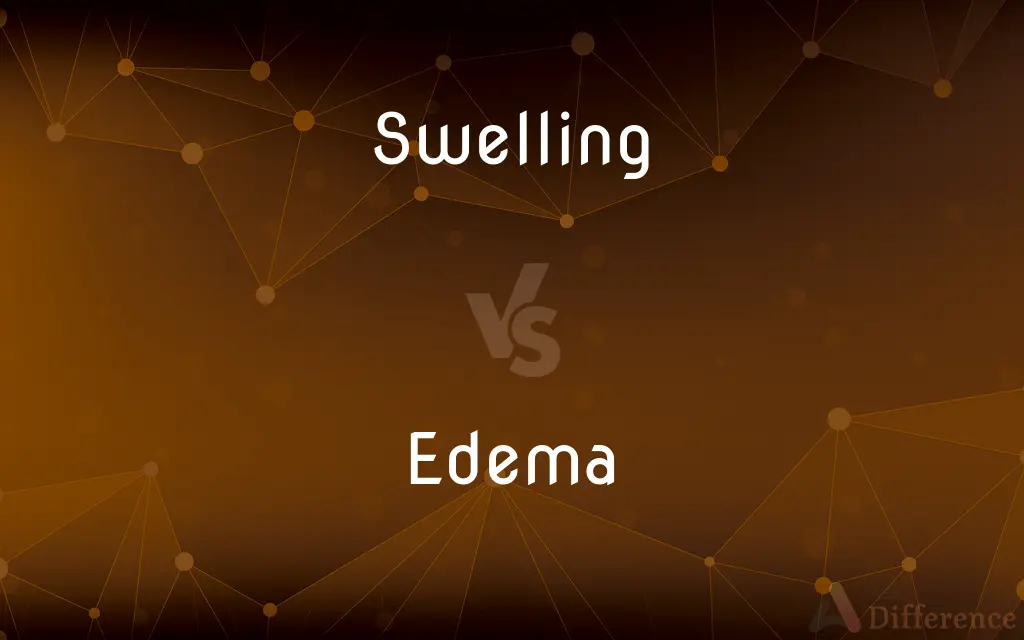Swelling vs. Edema — What's the Difference?
By Tayyaba Rehman & Urooj Arif — Updated on March 14, 2024
Swelling is a general term for an increase in size or volume, often due to inflammation or fluid accumulation, whereas edema specifically refers to the accumulation of excess fluid in body tissues, causing swelling.

Difference Between Swelling and Edema
Table of Contents
ADVERTISEMENT
Key Differences
Swelling can result from various causes, including inflammation, injury, or an underlying health condition, and it can occur in any part of the body. Edema, a type of swelling, is characterized by the accumulation of excess fluid within the body tissues, leading to noticeable swelling, particularly in the extremities, such as legs, feet, and arms.
While swelling can be a temporary response to an injury or inflammation, serving as a protective mechanism to initiate healing, edema often indicates a more systemic issue related to the circulatory system, lymphatic system, or kidneys. For example, a sprained ankle may swell as part of the body's natural response to injury, whereas edema in the legs might be due to heart failure or chronic venous insufficiency.
The detection and evaluation of swelling and edema can involve different approaches. Swelling may be assessed through its appearance, tenderness, and warmth, indicating inflammation. In contrast, edema is often evaluated through physical examination techniques, such as pressing on the swollen area to see if it leaves an indentation (pitting edema).
Management and treatment of swelling and edema can vary based on their underlying causes. General swelling due to injury may be treated with rest, ice, compression, and elevation (RICE), whereas edema may require more specific treatments targeting the underlying condition, such as diuretics for fluid retention or lifestyle changes for chronic conditions.
Comparison Chart
Definition
An increase in size or volume, often due to inflammation or fluid accumulation.
A specific type of swelling caused by excess fluid trapped in body tissues.
ADVERTISEMENT
Causes
Injury, inflammation, underlying health conditions.
Circulatory system issues, lymphatic system dysfunction, kidney problems.
Common Locations
Can occur anywhere in the body.
Often seen in extremities like legs, feet, and arms.
Indications
Can be a temporary protective response to injury.
Often indicates more systemic issues.
Evaluation
Appearance, tenderness, warmth.
Physical examination, pitting test.
Treatment
RICE (Rest, Ice, Compression, Elevation), anti-inflammatory medications.
Diuretics, lifestyle changes, addressing underlying conditions.
Compare with Definitions
Swelling
Can occur in response to an allergen or infection.
Bee stings often cause significant swelling at the site.
Edema
The accumulation of fluid in the body's tissues, causing swelling.
Edema in her legs made it difficult to wear her regular shoes.
Swelling
May be accompanied by redness, warmth, and pain.
The swelling in his knee was warm and painful to touch.
Edema
Can be classified as pitting or non-pitting based on its physical characteristics.
The doctor checked for pitting edema by pressing on the swollen area.
Swelling
An increase in size or volume due to accumulation of fluid or other substances.
The swelling around her sprained ankle was noticeable.
Edema
Often a symptom of underlying health issues like heart failure.
Cardiac edema can be a sign of worsening heart condition.
Swelling
A natural response to injury or inflammation.
Swelling is the body's way of protecting the injured area.
Edema
May require lifestyle changes or medication for management.
Reducing salt intake can help manage edema.
Swelling
Can affect any part of the body, including internal organs.
Swelling of the liver can indicate a serious condition.
Edema
Can lead to increased risk of skin infections or ulcers in severe cases.
Persistent edema in the lower limbs can lead to skin breakdown and infection.
Swelling
The state of being swollen.
Edema
Edema, also spelled oedema, and also known as fluid retention, dropsy, hydropsy and swelling, is the build-up of fluid in the body's tissue. Most commonly, the legs or arms are affected.
Swelling
Something swollen, especially an abnormally swollen body part or area.
Edema
(Medicine)An excessive accumulation of serous fluid in tissue spaces or a body cavity.
Swelling
The state of being swollen.
Edema
(Botany)A condition of plants characterized by blisterlike swellings on the leaves or other parts, caused by an accumulation of water.
Swelling
Anything swollen, especially any abnormally swollen part of the body.
Edema
An excessive accumulation of serum in tissue spaces or a body cavity.
Swelling
(figurative) A rising, as of passion or anger.
Edema
A similar swelling in plants caused by excessive accumulation of water.
Swelling
Present participle of swell
Edema
Same as œdema.
Swelling
The act of that which swells; as, the swelling of rivers in spring; the swelling of the breast with pride.
Rise to the swelling of the voiceless sea.
Edema
Swelling from excessive accumulation of serous fluid in tissue
Swelling
A protuberance; a prominence
The superficies of such plates are not even, but have many cavities and swellings.
Swelling
Abnormal protuberance or localized enlargement
Swelling
The swelling of certain substances when they are heated (often accompanied by release of water)
Swelling
Becoming puffy as from internal bleeding or accumulation of other fluids;
Put ice on the swelling ankle
Common Curiosities
What is the primary difference between swelling and edema?
Swelling is a general term for any increase in size or volume, often due to fluid accumulation or inflammation, while edema specifically refers to the accumulation of excess fluid in body tissues.
How is pitting edema identified?
Pitting edema is identified by pressing on the swollen area; if it leaves an indentation, it is considered pitting edema.
Is swelling always a sign of an underlying disease?
Not always; swelling can be a temporary response to an injury or inflammation but can also indicate an underlying health condition.
Can edema occur without swelling?
Edema is a type of swelling; therefore, it cannot occur without presenting as swelling. However, not all swelling is due to edema.
What treatments are available for general swelling?
Treatments for general swelling may include rest, ice, compression, elevation (RICE), and anti-inflammatory medications.
Are there any dietary recommendations for managing edema?
Reducing salt intake and maintaining a balanced diet can help manage edema by reducing fluid retention.
What is the role of diuretics in treating edema?
Diuretics help remove excess fluid from the body through urination, thus reducing edema.
Can exercise help in managing edema?
Moderate exercise can improve circulation and lymphatic drainage, potentially helping to reduce edema.
What are common causes of edema?
Common causes of edema include issues with the circulatory or lymphatic systems, kidney problems, and certain medications.
Can elevation help in reducing edema?
Yes, elevating the affected limbs can help reduce edema by facilitating fluid drainage back towards the heart.
How does heart failure lead to edema?
Heart failure can cause fluid to accumulate in the body because the heart is unable to pump efficiently, leading to edema, especially in the lower limbs.
What is lymphedema and how is it related to edema?
Lymphedema is a type of edema caused by a blockage in the lymphatic system, leading to fluid accumulation in the affected area.
How does edema affect daily life?
Edema can cause discomfort, difficulty in wearing clothes or shoes, limited mobility, and in severe cases, skin infections or ulcers.
Is it possible for edema to resolve on its own?
Mild cases of edema can resolve on their own, especially with lifestyle changes, but persistent or severe edema requires medical attention.
Share Your Discovery

Previous Comparison
Adnate vs. Connate
Next Comparison
Mortgage vs. BondAuthor Spotlight
Written by
Tayyaba RehmanTayyaba Rehman is a distinguished writer, currently serving as a primary contributor to askdifference.com. As a researcher in semantics and etymology, Tayyaba's passion for the complexity of languages and their distinctions has found a perfect home on the platform. Tayyaba delves into the intricacies of language, distinguishing between commonly confused words and phrases, thereby providing clarity for readers worldwide.
Co-written by
Urooj ArifUrooj is a skilled content writer at Ask Difference, known for her exceptional ability to simplify complex topics into engaging and informative content. With a passion for research and a flair for clear, concise writing, she consistently delivers articles that resonate with our diverse audience.














































